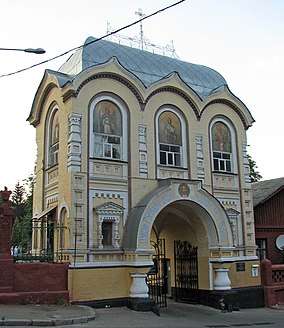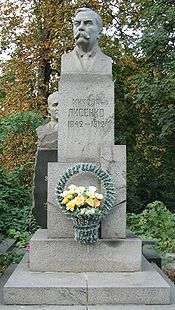Baikove Cemetery
Baikove Cemetery (Ukrainian: Байкове кладовище) is an historic cemetery memorial in Holosiiv Raion of Kiev, Ukraine. It is a National Historic Landmark of Ukraine and is known as a necropolis of distinguished people. It was established in 1833. Among the buried, it includes Mykhailo Hrushevskyi, Lesya Ukrainka, Slava Stetsko, Viacheslav Chornovil, Oles Honchar, Ivan Nechuy-Levytsky, Olena Pchilka, Mykhailo Starytsky, Oleksandr Bilash, Ostap Vyshnya, Ivan Mykolaychuk, Volodymyr Shcherbytsky, Leonid Telyatnikov, Mikhail Vaschenko-Zakharchenko, Oleg Antonov and Valeri Lobanovsky.
| Baikove Cemetery | |
|---|---|
 Main entrance to Baikove Cemetery | |
 | |
| Location | Kiev, Ukraine |
| Coordinates | 50°25.00′N 30°30.35′E |
| Area | 72.47 ha (179.1 acres) |
| Established | 1833 |
| Named for | General Sergei Baikov |
History
The cemetery was established in 1833. It has got its name from the nearby Baikovo estate. The oldest part of the cemetery is located south of the present vul. Baikova. The biggest part is located north of the street and was established in the 1880s. It is partly surrounded by a wall. Besides the Orthodox graves there are also Catholic and Lutheran sections.
In Soviet times the Baikove cemetery became the main necropolis of the Kiev's intelligentsia, middle and upper classes. Many of the headstones became pieces of monumental art. Also after the Ukrainian independence the cemetery has remained the most prestigious burial ground in the city. There 87 National Landmarks of History.
An Orthodox Church (Ascension of the Lord) in Byzantine style was built at the cemetery in 1884–1889. It was built on the proceeds from the sale of burial places. During the Soviet times it was preserved as a memorial hall for funeral ceremonies. Today it is again used as a church. In 1975 a new crematorium in modern style was built in the western part of the cemetery.
Gallery
- The writer Lesya Ukrainka's grave
 The composer Mykola Lysenko's grave
The composer Mykola Lysenko's grave- Hvojka Vіkentіj's grave
 Section 52a where several notable Ukrainians like Valeri Lobanovsky and Vadym Hetman are buried.
Section 52a where several notable Ukrainians like Valeri Lobanovsky and Vadym Hetman are buried.
See also
- People buried at the Baikove
- List of cultural heritage landmarks of national significance in Kiev
Further reading
| Wikimedia Commons has media related to Baikove Cemetery. |
- Ruta Malikenaite (ed): Touring Kyiv. Guidebook, p.153–157 (Baltija Druk 2002).
External links
- Entsyklopediya Kyiv
- Mysterious places of Kiev: Baikove Cemetery (Загадкові місця Києва: Байкове кладовище). ForUM. 28 November 2011
- Habdrakhimov, D. Baikove Cemetery: so who is being buried at the elite necropolis? (Байкове кладовище: так кого ж ховають на "елітному некрополі"?) Ukrainian National News (UNN). 12 June 2012
- In Kiev hunters for metal destroyed the Baikove Cemetery (У Києві мисливці за металом розгромили Байкове кладовище). Segodnya. 8 October 2015.
- Malenkov, R. Baikove Necropolis (Байковий некрополь). Ukraina Incognita. 2007